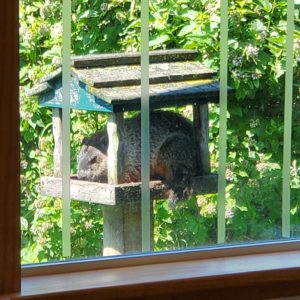By Kennedy Zittel, Assistant Naturalist
Now that the weather has gotten colder, we have begun to say goodbye (for now) to some of our animal friends here at Woodland Dunes. With the cold comes hibernation, and one of our hibernating friends is the woodchuck! Woodchucks (Marmota monax) are large rodents that belong to the squirrel family. On average woodchucks are 16-27 inches from the tip of their nose to the tip of their tail and they can weigh roughly around 10 pounds. Woodchucks are diurnal, meaning that they are awake during the day, so when they are not hibernating we often get to see them around the nature center buildings. The ones here spend their days sunning themselves on the boardwalk behind the barn, sitting on top of the deck railing to get a better view, and occasionally climbing into the bird feeders to munch on seed. And to be honest, since it happens infrequently it is pretty comical watching the round rodent try to squeeze into the little bird feeder. Making the 3 foot climb to the birdfeeder is no trouble for a woodchuck, in fact, they are actually very good climbers and can even be commonly seen sitting up in trees.
 Staying within a few hundred feet of their dens, woodchucks will only travel long distances to search for food or to find a mate (mating season for them is March-April). Young woodchucks will only stay a short period with their mom, and leave the den mid-July. Hibernating October to March, woodchucks have to spend the rest of the months building up fat reserves to help them survive sleeping through winter. Contrary to their name, woodchucks have very little to do with wood. They mostly feed on a variety of fruits and green plants, with the occasional flower, insect, and tree bark. Their name doesn’t refer to wood at all, instead it is derived from the Algonquian word for them, wuchak.
Staying within a few hundred feet of their dens, woodchucks will only travel long distances to search for food or to find a mate (mating season for them is March-April). Young woodchucks will only stay a short period with their mom, and leave the den mid-July. Hibernating October to March, woodchucks have to spend the rest of the months building up fat reserves to help them survive sleeping through winter. Contrary to their name, woodchucks have very little to do with wood. They mostly feed on a variety of fruits and green plants, with the occasional flower, insect, and tree bark. Their name doesn’t refer to wood at all, instead it is derived from the Algonquian word for them, wuchak.
Often people refer to woodchucks as “pests” but really they are just trying to live as they normally do in an ever-shrinking habitat. As we humans continue to spread out we will just have to learn and appreciate coexisting with the wildlife that was already here.
Woodchucks play an important part in the local ecosystem. In addition to being food for other animals, they provide farmers and gardeners with some helpful things. When they dig, woodchucks aerate the soil allowing for plant roots to get oxygen. The digging and burrowing also helps to mix up the soil so plants can absorb nutrients that they wouldn’t have gotten otherwise. Organic matter accumulates on the top of the soil whereas other nutrients like calcium, iron, and phosphorus often sink deeper into the soil with rainwater, so by digging, those nutrients can reach the plant roots closer to the surface and the organic matter can sink deeper for things like earthworms to munch on. Their burrows also provide homes for amphibians, reptiles, chipmunks, and other small mammals after the woodchucks have left. One cool thing is that even when woodchucks are still using their burrows and dens, other hibernating animals will go into one of the burrow rooms for the winter! This means that other animals like possums, raccoons, skunks, and rabbits can all be roommates with woodchucks over winter.
Now, if that isn’t enough reasoning for why they are neat to have around, woodchucks are also responsible for two major archeological discoveries! In Ohio at the Ufferman Site woodchucks unearthed countless artifacts that were from a Cole Native American village. In Pennsylvania, a woodchuck unearthed artifacts that helped scientists discover the 19,000 year old Meadowcroft Rockshelter site – which is the oldest evidence of humans in the Americas ever found.
Not only are woodchucks good for the soil and other animals, but they have helped us understand more about our history. So the next time you see a woodchuck digging around, instead of being upset over it, think of what it is doing for the soil, and perhaps check out the area after it leaves. As you never know what cool discoveries those little furry archeologists may dig up.
photo of woodchuck in feeder by Kennedy Zittel
